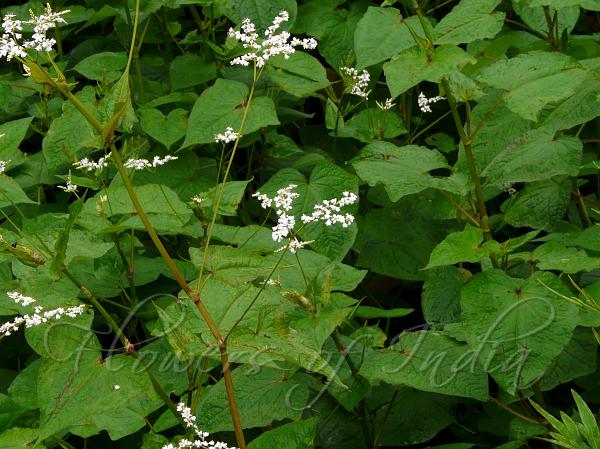|
| Perennial Buckwheat |
|

|

| File size | 526560 |
| Original date | 6/25/11 10:22 AM |
| Resolution | 2048 x 1536 |
| Flash | Flash did not fire, auto |
| Focal length | 15.4mm |
| Exposure time | 1/320s |
| Aperture | 5.6 |
| Focus Distance | |
| Metering Mode | Spot |
| Camera make | Panasonic |
| Camera model | DMC-FZ18 |
| Sensor type | OneChipColorArea |
|
|
|
|
Photo: |
Botanical name: Fagopyrum cymosum Family: Polygonaceae (Knotweed family)
Synonyms: Polygonum dibotrys, Fagopyrum dibotrys, Polygonum cymosum
Synonyms: Polygonum dibotrys, Fagopyrum dibotrys, Polygonum cymosum
Perennial Buckwheat is a tall, perennial, sparsely
velvety, branched herb. Leaves are carried on 1.5-7 cm long stalks -
upper stalks are short and the lower ones long. Leaves are broadly
triangular, arrow-shaped or heart-shaped, long-pointed, 7-10 x 2.5-7
cm. Ochreae are 0.8-1.2 cm long, brown, tubular, truncate, membranous.
Flowers are borne one-sided on the long recurved branches of the
inflorescence. Flowers are stalked, white. The stalk carrying the
cluster, is 6-16 cm long. Tepals are 5, 2-3 mm long. Stamens are 8,
alternating with glands. Ovary is 3-angled, styles 3. Nuts are
3-angled, angles acute, ovate, 6-8 mm long, about 5 mm broad with flat
or concave surfaces. Perennial Buckwheat is found in the Himalayas, in
Bhutan, Kashmir, Myanmar, Nepal, Sikkim and Vietnam, at altitudes of
1500-3400 m. Flowering: May-September.
Medicinal uses: The whole plant is anodyne, anthelmintic,
antiphlogistic, carminative,
depurative and febrifuge. It stimulates blood circulation. A decoction
is
used in the treatment of traumatic injuries, lumbago, menstrual
irregularities, purulent infections, snake and insect bites.
The whole plant is anodyne, anthelmintic,
antiphlogistic, carminative,
depurative and febrifuge. It stimulates blood circulation. A decoction
is
used in the treatment of traumatic injuries, lumbago, menstrual
irregularities, purulent infections, snake and insect bites.
Medicinal uses:
 The whole plant is anodyne, anthelmintic,
antiphlogistic, carminative,
depurative and febrifuge. It stimulates blood circulation. A decoction
is
used in the treatment of traumatic injuries, lumbago, menstrual
irregularities, purulent infections, snake and insect bites.
The whole plant is anodyne, anthelmintic,
antiphlogistic, carminative,
depurative and febrifuge. It stimulates blood circulation. A decoction
is
used in the treatment of traumatic injuries, lumbago, menstrual
irregularities, purulent infections, snake and insect bites. | Identification credit: Tabish | Photographed in Lachung, Sikkim. |
• Is this flower misidentified? If yes,